Australian Regional and Remote Community Services: Agency Report
VerifiedAdded on 2022/09/16
|13
|2706
|19
Report
AI Summary
This report analyzes the Australian Regional and Remote Community Services (ARRCS), focusing on its operations in remote and regional communities. The report details the organization's structure, service delivery models like the 'community of practice' and 'two-tiered funding' models, strengths such as compassion and holistic care, and weaknesses including the need for improved communication and staffing strategies. It also examines the sustainability of the service model, challenges in staffing and worker retention, and ethical dilemmas faced by human service workers, such as community pressure and boundary crossings. The report includes an interview with the organization's head, providing evidence for the service model and insights into various aspects of service design and delivery. The conclusion emphasizes ARRCS's commitment to delivering high-quality services and working collaboratively with Indigenous Australians. The report is a comprehensive overview of ARRCS's operations and challenges in the context of remote community service delivery.
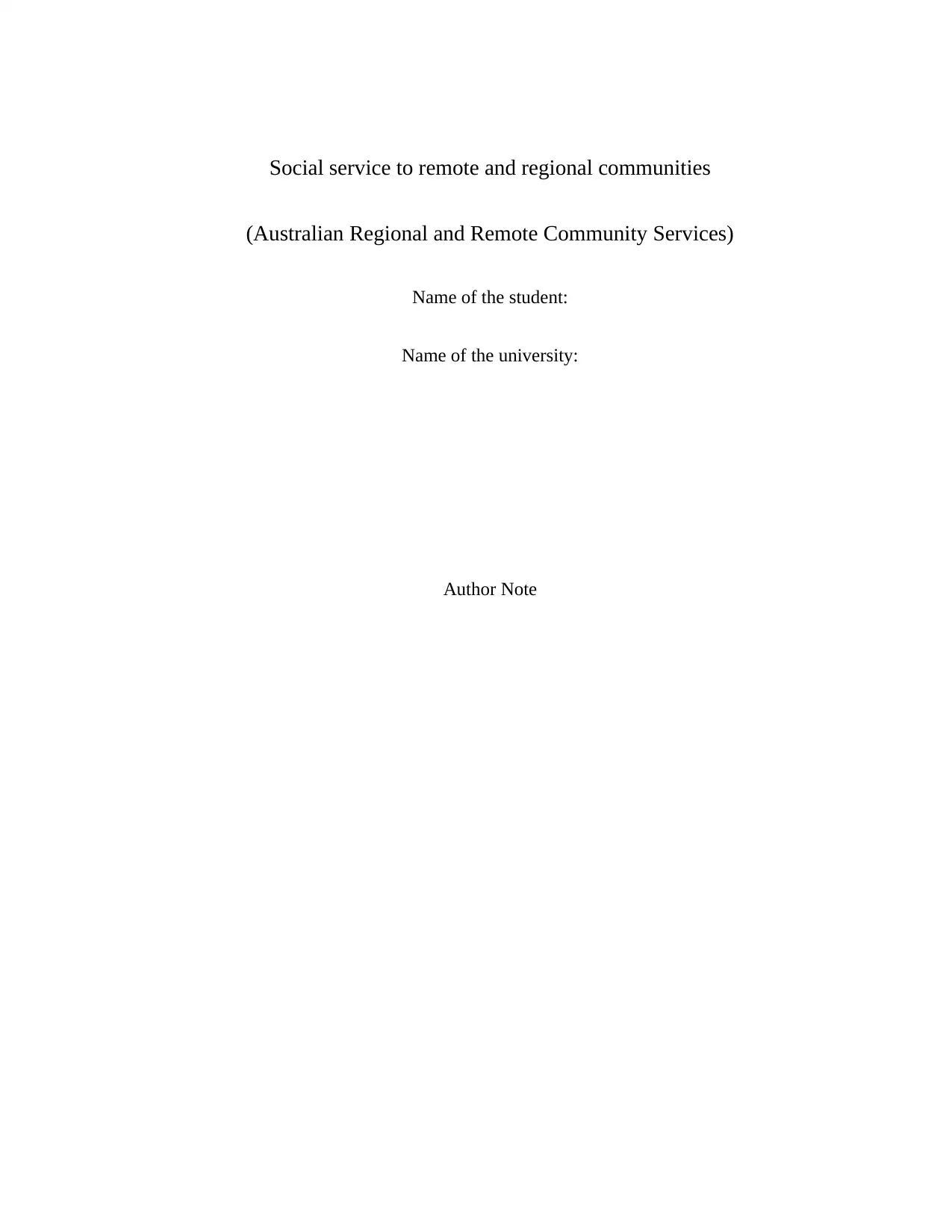
Social service to remote and regional communities
(Australian Regional and Remote Community Services)
Name of the student:
Name of the university:
Author Note
(Australian Regional and Remote Community Services)
Name of the student:
Name of the university:
Author Note
Paraphrase This Document
Need a fresh take? Get an instant paraphrase of this document with our AI Paraphraser

1
Executive summary
The Australian Regional and Remote Community Services or ARRCS delivers a responsive and
flexible supporting range. They care about the individual necessities needing that every time. In the
following analysis, the type of organization with the models of service delivery must be applied for
distant service delivery is discussed. Further, the weaknesses and strengths, according to the
sustainability and representative of the service model, are also demonstrated here. Next, various
changes in staffing and maintenance of workers at the Australian Regional and Remote Community
Services is found out. At last, various ethical apprehensions to be encountered by the human service
workers for distant delivery is determined in the study.
Executive summary
The Australian Regional and Remote Community Services or ARRCS delivers a responsive and
flexible supporting range. They care about the individual necessities needing that every time. In the
following analysis, the type of organization with the models of service delivery must be applied for
distant service delivery is discussed. Further, the weaknesses and strengths, according to the
sustainability and representative of the service model, are also demonstrated here. Next, various
changes in staffing and maintenance of workers at the Australian Regional and Remote Community
Services is found out. At last, various ethical apprehensions to be encountered by the human service
workers for distant delivery is determined in the study.

2
Table of Contents
Introduction:..........................................................................................................................................3
Discussion on organization type:...........................................................................................................3
Service delivery models used:...............................................................................................................3
Strengths and limitations determined from the side of the representative:...........................................4
Strengths:...........................................................................................................................................4
Weaknesses:.......................................................................................................................................4
Sustainability of service model:.............................................................................................................5
Concerns with retention and staffing the workers under ARRCS:........................................................5
Ethical dilemmas that are encountered by human service workers in delivering remote services:.......6
Questions and responses from the interview conducted:.......................................................................6
Details of the interview:.....................................................................................................................6
Questions and answers:......................................................................................................................7
Conclusion:............................................................................................................................................9
References:..........................................................................................................................................11
Table of Contents
Introduction:..........................................................................................................................................3
Discussion on organization type:...........................................................................................................3
Service delivery models used:...............................................................................................................3
Strengths and limitations determined from the side of the representative:...........................................4
Strengths:...........................................................................................................................................4
Weaknesses:.......................................................................................................................................4
Sustainability of service model:.............................................................................................................5
Concerns with retention and staffing the workers under ARRCS:........................................................5
Ethical dilemmas that are encountered by human service workers in delivering remote services:.......6
Questions and responses from the interview conducted:.......................................................................6
Details of the interview:.....................................................................................................................6
Questions and answers:......................................................................................................................7
Conclusion:............................................................................................................................................9
References:..........................................................................................................................................11
⊘ This is a preview!⊘
Do you want full access?
Subscribe today to unlock all pages.

Trusted by 1+ million students worldwide
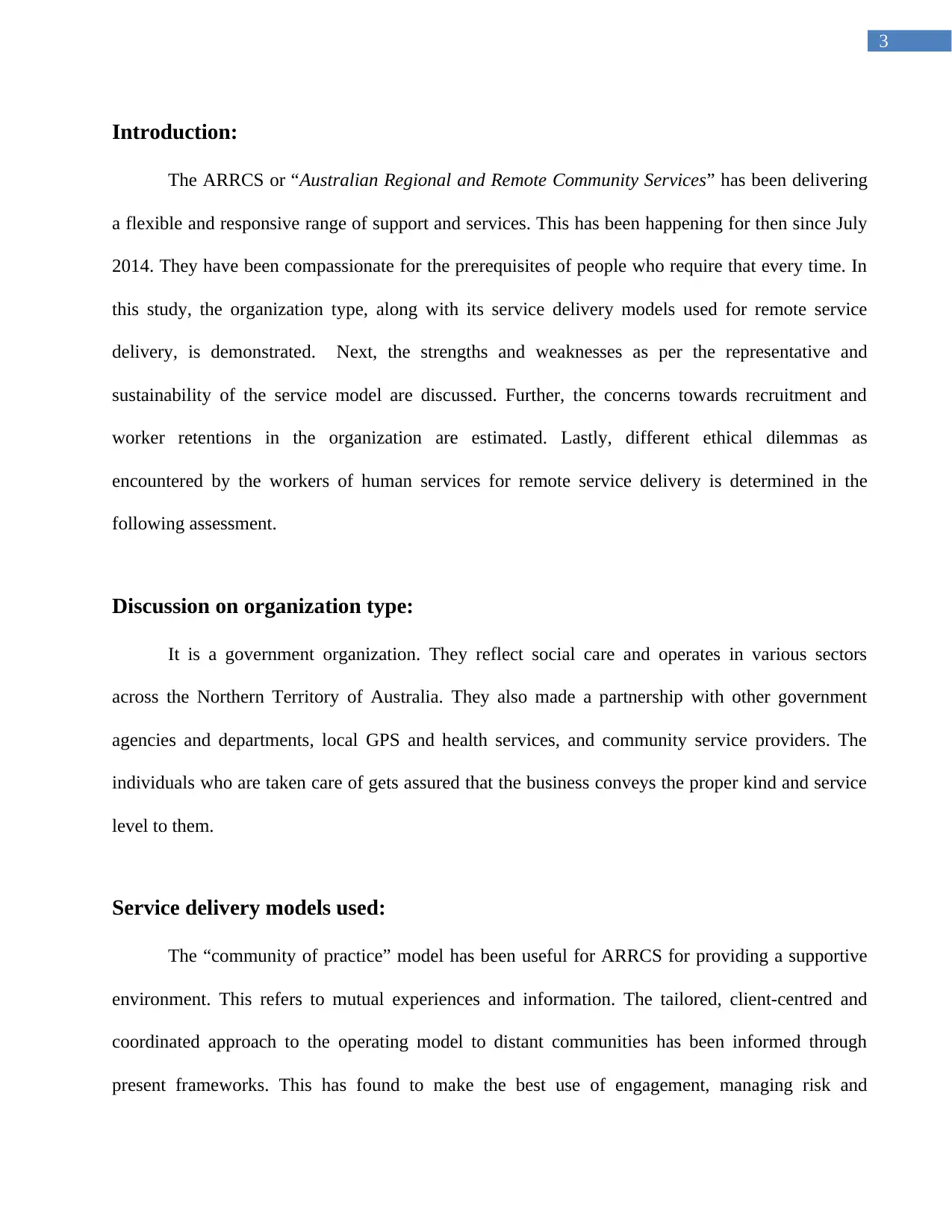
3
Introduction:
The ARRCS or “Australian Regional and Remote Community Services” has been delivering
a flexible and responsive range of support and services. This has been happening for then since July
2014. They have been compassionate for the prerequisites of people who require that every time. In
this study, the organization type, along with its service delivery models used for remote service
delivery, is demonstrated. Next, the strengths and weaknesses as per the representative and
sustainability of the service model are discussed. Further, the concerns towards recruitment and
worker retentions in the organization are estimated. Lastly, different ethical dilemmas as
encountered by the workers of human services for remote service delivery is determined in the
following assessment.
Discussion on organization type:
It is a government organization. They reflect social care and operates in various sectors
across the Northern Territory of Australia. They also made a partnership with other government
agencies and departments, local GPS and health services, and community service providers. The
individuals who are taken care of gets assured that the business conveys the proper kind and service
level to them.
Service delivery models used:
The “community of practice” model has been useful for ARRCS for providing a supportive
environment. This refers to mutual experiences and information. The tailored, client-centred and
coordinated approach to the operating model to distant communities has been informed through
present frameworks. This has found to make the best use of engagement, managing risk and
Introduction:
The ARRCS or “Australian Regional and Remote Community Services” has been delivering
a flexible and responsive range of support and services. This has been happening for then since July
2014. They have been compassionate for the prerequisites of people who require that every time. In
this study, the organization type, along with its service delivery models used for remote service
delivery, is demonstrated. Next, the strengths and weaknesses as per the representative and
sustainability of the service model are discussed. Further, the concerns towards recruitment and
worker retentions in the organization are estimated. Lastly, different ethical dilemmas as
encountered by the workers of human services for remote service delivery is determined in the
following assessment.
Discussion on organization type:
It is a government organization. They reflect social care and operates in various sectors
across the Northern Territory of Australia. They also made a partnership with other government
agencies and departments, local GPS and health services, and community service providers. The
individuals who are taken care of gets assured that the business conveys the proper kind and service
level to them.
Service delivery models used:
The “community of practice” model has been useful for ARRCS for providing a supportive
environment. This refers to mutual experiences and information. The tailored, client-centred and
coordinated approach to the operating model to distant communities has been informed through
present frameworks. This has found to make the best use of engagement, managing risk and
Paraphrase This Document
Need a fresh take? Get an instant paraphrase of this document with our AI Paraphraser
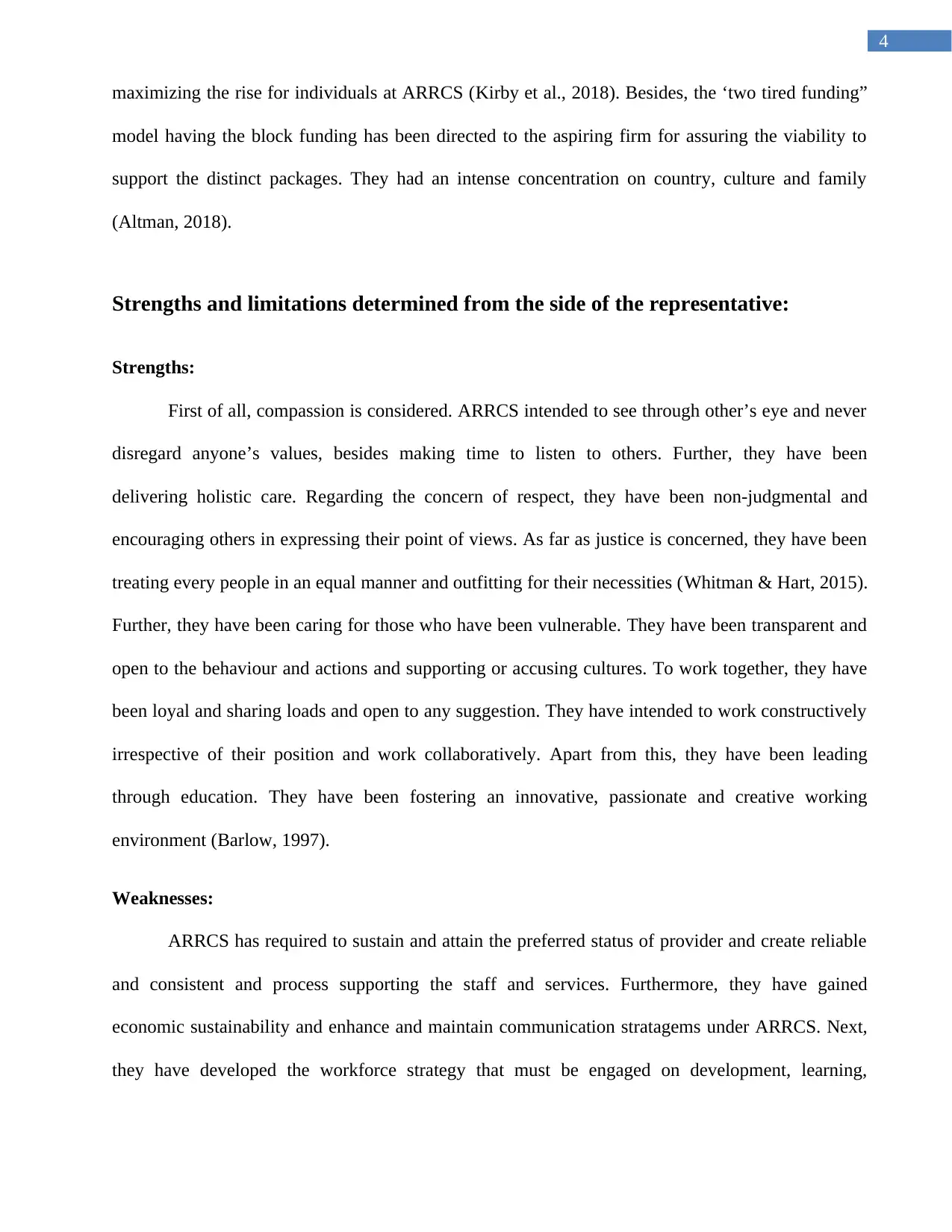
4
maximizing the rise for individuals at ARRCS (Kirby et al., 2018). Besides, the ‘two tired funding”
model having the block funding has been directed to the aspiring firm for assuring the viability to
support the distinct packages. They had an intense concentration on country, culture and family
(Altman, 2018).
Strengths and limitations determined from the side of the representative:
Strengths:
First of all, compassion is considered. ARRCS intended to see through other’s eye and never
disregard anyone’s values, besides making time to listen to others. Further, they have been
delivering holistic care. Regarding the concern of respect, they have been non-judgmental and
encouraging others in expressing their point of views. As far as justice is concerned, they have been
treating every people in an equal manner and outfitting for their necessities (Whitman & Hart, 2015).
Further, they have been caring for those who have been vulnerable. They have been transparent and
open to the behaviour and actions and supporting or accusing cultures. To work together, they have
been loyal and sharing loads and open to any suggestion. They have intended to work constructively
irrespective of their position and work collaboratively. Apart from this, they have been leading
through education. They have been fostering an innovative, passionate and creative working
environment (Barlow, 1997).
Weaknesses:
ARRCS has required to sustain and attain the preferred status of provider and create reliable
and consistent and process supporting the staff and services. Furthermore, they have gained
economic sustainability and enhance and maintain communication stratagems under ARRCS. Next,
they have developed the workforce strategy that must be engaged on development, learning,
maximizing the rise for individuals at ARRCS (Kirby et al., 2018). Besides, the ‘two tired funding”
model having the block funding has been directed to the aspiring firm for assuring the viability to
support the distinct packages. They had an intense concentration on country, culture and family
(Altman, 2018).
Strengths and limitations determined from the side of the representative:
Strengths:
First of all, compassion is considered. ARRCS intended to see through other’s eye and never
disregard anyone’s values, besides making time to listen to others. Further, they have been
delivering holistic care. Regarding the concern of respect, they have been non-judgmental and
encouraging others in expressing their point of views. As far as justice is concerned, they have been
treating every people in an equal manner and outfitting for their necessities (Whitman & Hart, 2015).
Further, they have been caring for those who have been vulnerable. They have been transparent and
open to the behaviour and actions and supporting or accusing cultures. To work together, they have
been loyal and sharing loads and open to any suggestion. They have intended to work constructively
irrespective of their position and work collaboratively. Apart from this, they have been leading
through education. They have been fostering an innovative, passionate and creative working
environment (Barlow, 1997).
Weaknesses:
ARRCS has required to sustain and attain the preferred status of provider and create reliable
and consistent and process supporting the staff and services. Furthermore, they have gained
economic sustainability and enhance and maintain communication stratagems under ARRCS. Next,
they have developed the workforce strategy that must be engaged on development, learning,
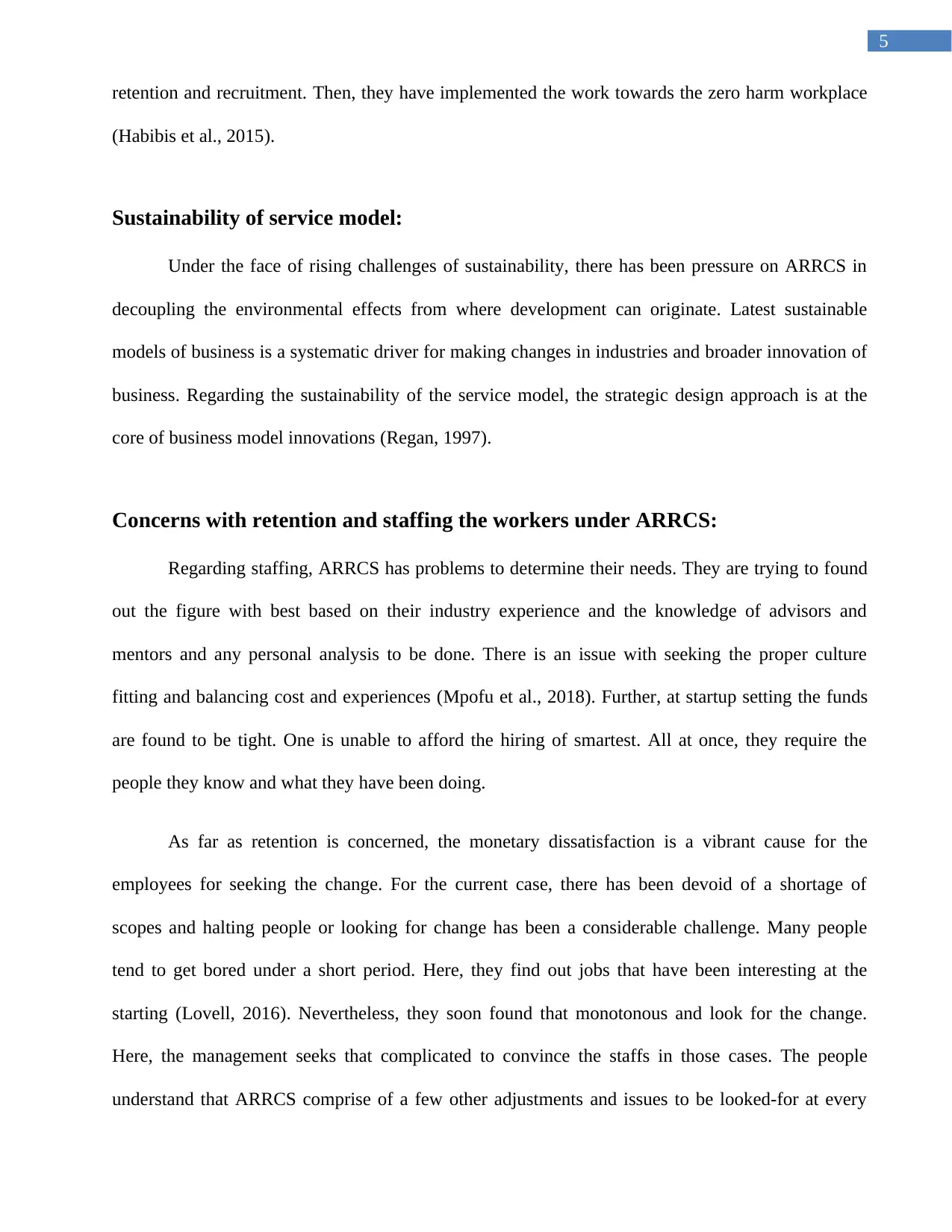
5
retention and recruitment. Then, they have implemented the work towards the zero harm workplace
(Habibis et al., 2015).
Sustainability of service model:
Under the face of rising challenges of sustainability, there has been pressure on ARRCS in
decoupling the environmental effects from where development can originate. Latest sustainable
models of business is a systematic driver for making changes in industries and broader innovation of
business. Regarding the sustainability of the service model, the strategic design approach is at the
core of business model innovations (Regan, 1997).
Concerns with retention and staffing the workers under ARRCS:
Regarding staffing, ARRCS has problems to determine their needs. They are trying to found
out the figure with best based on their industry experience and the knowledge of advisors and
mentors and any personal analysis to be done. There is an issue with seeking the proper culture
fitting and balancing cost and experiences (Mpofu et al., 2018). Further, at startup setting the funds
are found to be tight. One is unable to afford the hiring of smartest. All at once, they require the
people they know and what they have been doing.
As far as retention is concerned, the monetary dissatisfaction is a vibrant cause for the
employees for seeking the change. For the current case, there has been devoid of a shortage of
scopes and halting people or looking for change has been a considerable challenge. Many people
tend to get bored under a short period. Here, they find out jobs that have been interesting at the
starting (Lovell, 2016). Nevertheless, they soon found that monotonous and look for the change.
Here, the management seeks that complicated to convince the staffs in those cases. The people
understand that ARRCS comprise of a few other adjustments and issues to be looked-for at every
retention and recruitment. Then, they have implemented the work towards the zero harm workplace
(Habibis et al., 2015).
Sustainability of service model:
Under the face of rising challenges of sustainability, there has been pressure on ARRCS in
decoupling the environmental effects from where development can originate. Latest sustainable
models of business is a systematic driver for making changes in industries and broader innovation of
business. Regarding the sustainability of the service model, the strategic design approach is at the
core of business model innovations (Regan, 1997).
Concerns with retention and staffing the workers under ARRCS:
Regarding staffing, ARRCS has problems to determine their needs. They are trying to found
out the figure with best based on their industry experience and the knowledge of advisors and
mentors and any personal analysis to be done. There is an issue with seeking the proper culture
fitting and balancing cost and experiences (Mpofu et al., 2018). Further, at startup setting the funds
are found to be tight. One is unable to afford the hiring of smartest. All at once, they require the
people they know and what they have been doing.
As far as retention is concerned, the monetary dissatisfaction is a vibrant cause for the
employees for seeking the change. For the current case, there has been devoid of a shortage of
scopes and halting people or looking for change has been a considerable challenge. Many people
tend to get bored under a short period. Here, they find out jobs that have been interesting at the
starting (Lovell, 2016). Nevertheless, they soon found that monotonous and look for the change.
Here, the management seeks that complicated to convince the staffs in those cases. The people
understand that ARRCS comprise of a few other adjustments and issues to be looked-for at every
⊘ This is a preview!⊘
Do you want full access?
Subscribe today to unlock all pages.

Trusted by 1+ million students worldwide
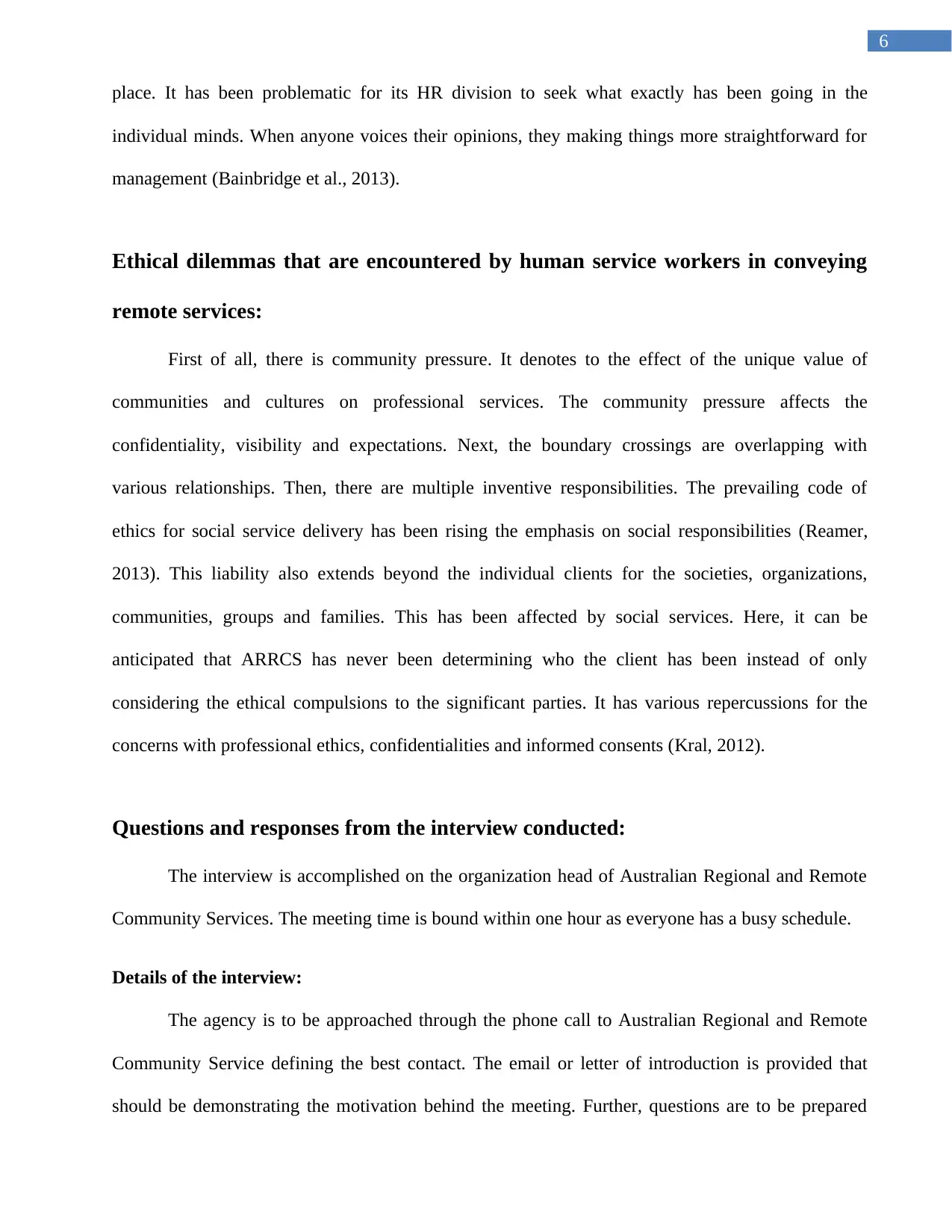
6
place. It has been problematic for its HR division to seek what exactly has been going in the
individual minds. When anyone voices their opinions, they making things more straightforward for
management (Bainbridge et al., 2013).
Ethical dilemmas that are encountered by human service workers in conveying
remote services:
First of all, there is community pressure. It denotes to the effect of the unique value of
communities and cultures on professional services. The community pressure affects the
confidentiality, visibility and expectations. Next, the boundary crossings are overlapping with
various relationships. Then, there are multiple inventive responsibilities. The prevailing code of
ethics for social service delivery has been rising the emphasis on social responsibilities (Reamer,
2013). This liability also extends beyond the individual clients for the societies, organizations,
communities, groups and families. This has been affected by social services. Here, it can be
anticipated that ARRCS has never been determining who the client has been instead of only
considering the ethical compulsions to the significant parties. It has various repercussions for the
concerns with professional ethics, confidentialities and informed consents (Kral, 2012).
Questions and responses from the interview conducted:
The interview is accomplished on the organization head of Australian Regional and Remote
Community Services. The meeting time is bound within one hour as everyone has a busy schedule.
Details of the interview:
The agency is to be approached through the phone call to Australian Regional and Remote
Community Service defining the best contact. The email or letter of introduction is provided that
should be demonstrating the motivation behind the meeting. Further, questions are to be prepared
place. It has been problematic for its HR division to seek what exactly has been going in the
individual minds. When anyone voices their opinions, they making things more straightforward for
management (Bainbridge et al., 2013).
Ethical dilemmas that are encountered by human service workers in conveying
remote services:
First of all, there is community pressure. It denotes to the effect of the unique value of
communities and cultures on professional services. The community pressure affects the
confidentiality, visibility and expectations. Next, the boundary crossings are overlapping with
various relationships. Then, there are multiple inventive responsibilities. The prevailing code of
ethics for social service delivery has been rising the emphasis on social responsibilities (Reamer,
2013). This liability also extends beyond the individual clients for the societies, organizations,
communities, groups and families. This has been affected by social services. Here, it can be
anticipated that ARRCS has never been determining who the client has been instead of only
considering the ethical compulsions to the significant parties. It has various repercussions for the
concerns with professional ethics, confidentialities and informed consents (Kral, 2012).
Questions and responses from the interview conducted:
The interview is accomplished on the organization head of Australian Regional and Remote
Community Services. The meeting time is bound within one hour as everyone has a busy schedule.
Details of the interview:
The agency is to be approached through the phone call to Australian Regional and Remote
Community Service defining the best contact. The email or letter of introduction is provided that
should be demonstrating the motivation behind the meeting. Further, questions are to be prepared
Paraphrase This Document
Need a fresh take? Get an instant paraphrase of this document with our AI Paraphraser

7
and then presented to the representative of the agency before the conference is needed. During the
meeting, permission is requested as the interview is chronicled through audio. Here, notes are taken
down while the interview is going on. It is to be assured that they are accurate.
Questions and answers:
Do you have any evidence base for the service model?
Answer: Yes, there are lots of substantiation base for the service model.
Are you positive while picking out this particular service model?
Answer: ARCCS is positive while selecting the service model.
Is a proper service valuation done for the service design?
Answer: ARCCS has conducted the investigation.
Have you accepted the mainstream ‘aged care funding” model that has been recurrently accepted for
providing the aged care along with the responsibility towards people having disabilities at distant
communities?
Answer: Absolutely, ARRCS has deployed the aged care funding model.
Is that better to bulk-fund the distant communities over the service basis and never on an individual
basis across the packaged care?
Answer: Bulk-fund is a practical tactic for the current scenario.
Have you been nurturing attributes and skills of their people and conceding to what they know and
oblige towards learning?
Answer: ARRCS has nurtured the skills and attributes needed.
and then presented to the representative of the agency before the conference is needed. During the
meeting, permission is requested as the interview is chronicled through audio. Here, notes are taken
down while the interview is going on. It is to be assured that they are accurate.
Questions and answers:
Do you have any evidence base for the service model?
Answer: Yes, there are lots of substantiation base for the service model.
Are you positive while picking out this particular service model?
Answer: ARCCS is positive while selecting the service model.
Is a proper service valuation done for the service design?
Answer: ARCCS has conducted the investigation.
Have you accepted the mainstream ‘aged care funding” model that has been recurrently accepted for
providing the aged care along with the responsibility towards people having disabilities at distant
communities?
Answer: Absolutely, ARRCS has deployed the aged care funding model.
Is that better to bulk-fund the distant communities over the service basis and never on an individual
basis across the packaged care?
Answer: Bulk-fund is a practical tactic for the current scenario.
Have you been nurturing attributes and skills of their people and conceding to what they know and
oblige towards learning?
Answer: ARRCS has nurtured the skills and attributes needed.
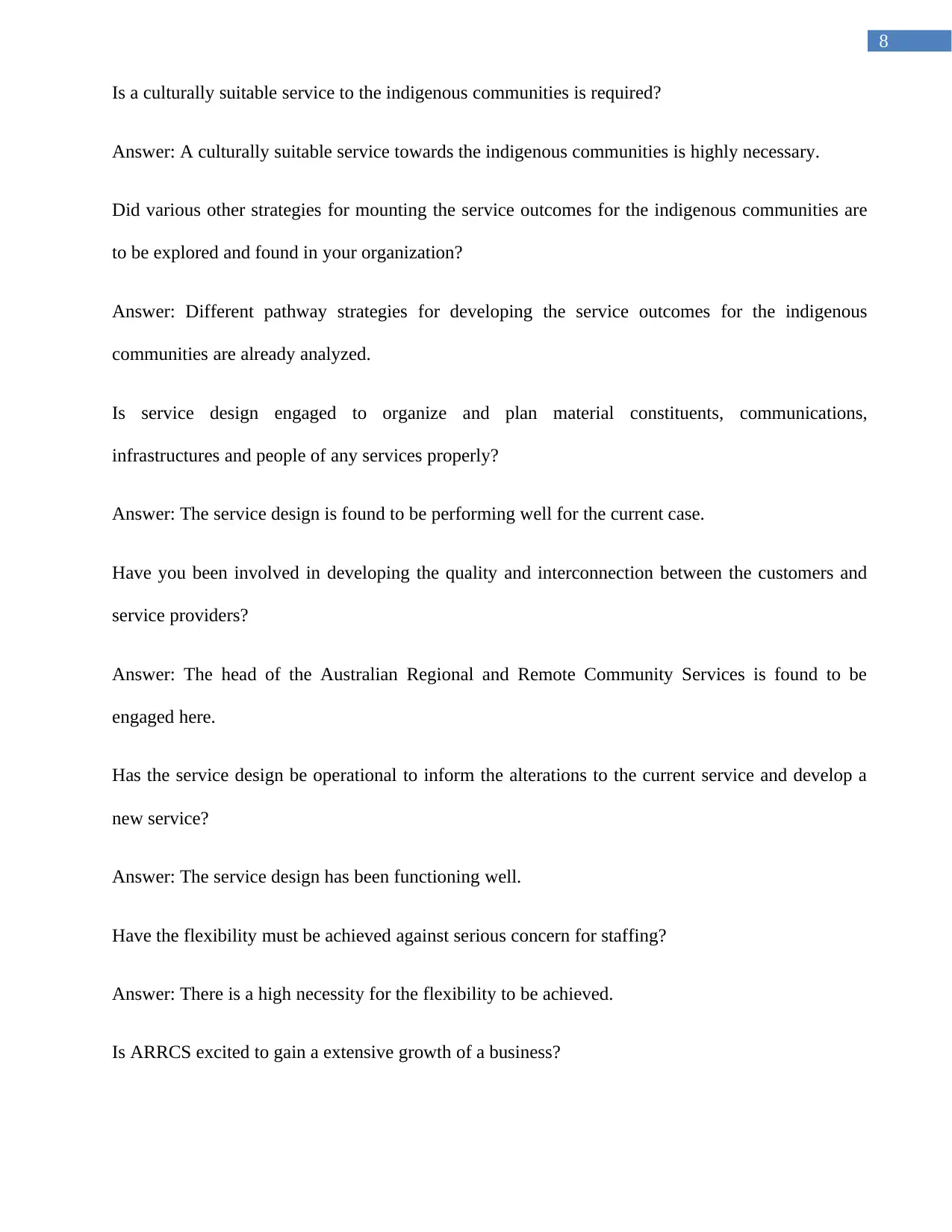
8
Is a culturally suitable service to the indigenous communities is required?
Answer: A culturally suitable service towards the indigenous communities is highly necessary.
Did various other strategies for mounting the service outcomes for the indigenous communities are
to be explored and found in your organization?
Answer: Different pathway strategies for developing the service outcomes for the indigenous
communities are already analyzed.
Is service design engaged to organize and plan material constituents, communications,
infrastructures and people of any services properly?
Answer: The service design is found to be performing well for the current case.
Have you been involved in developing the quality and interconnection between the customers and
service providers?
Answer: The head of the Australian Regional and Remote Community Services is found to be
engaged here.
Has the service design be operational to inform the alterations to the current service and develop a
new service?
Answer: The service design has been functioning well.
Have the flexibility must be achieved against serious concern for staffing?
Answer: There is a high necessity for the flexibility to be achieved.
Is ARRCS excited to gain a extensive growth of a business?
Is a culturally suitable service to the indigenous communities is required?
Answer: A culturally suitable service towards the indigenous communities is highly necessary.
Did various other strategies for mounting the service outcomes for the indigenous communities are
to be explored and found in your organization?
Answer: Different pathway strategies for developing the service outcomes for the indigenous
communities are already analyzed.
Is service design engaged to organize and plan material constituents, communications,
infrastructures and people of any services properly?
Answer: The service design is found to be performing well for the current case.
Have you been involved in developing the quality and interconnection between the customers and
service providers?
Answer: The head of the Australian Regional and Remote Community Services is found to be
engaged here.
Has the service design be operational to inform the alterations to the current service and develop a
new service?
Answer: The service design has been functioning well.
Have the flexibility must be achieved against serious concern for staffing?
Answer: There is a high necessity for the flexibility to be achieved.
Is ARRCS excited to gain a extensive growth of a business?
⊘ This is a preview!⊘
Do you want full access?
Subscribe today to unlock all pages.

Trusted by 1+ million students worldwide
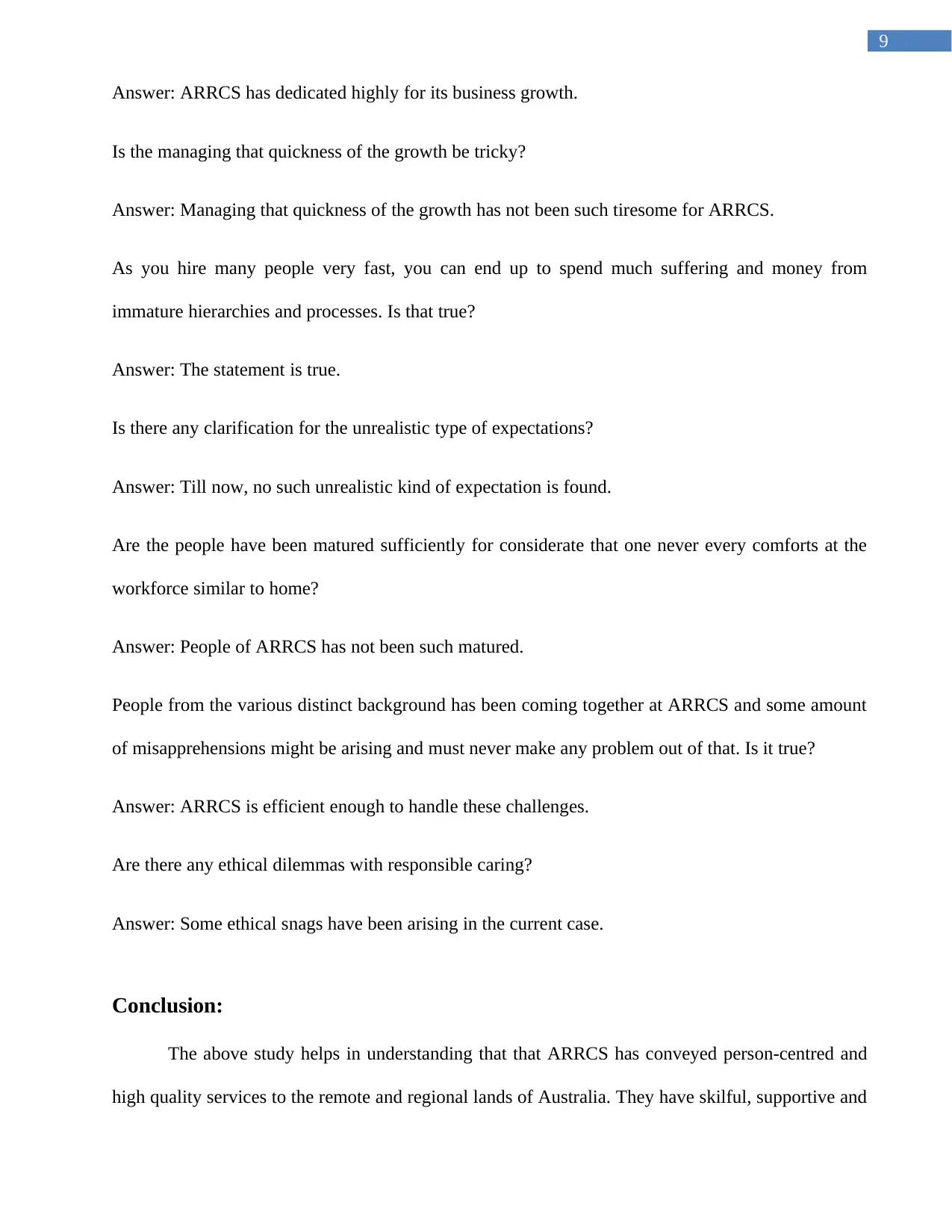
9
Answer: ARRCS has dedicated highly for its business growth.
Is the managing that quickness of the growth be tricky?
Answer: Managing that quickness of the growth has not been such tiresome for ARRCS.
As you hire many people very fast, you can end up to spend much suffering and money from
immature hierarchies and processes. Is that true?
Answer: The statement is true.
Is there any clarification for the unrealistic type of expectations?
Answer: Till now, no such unrealistic kind of expectation is found.
Are the people have been matured sufficiently for considerate that one never every comforts at the
workforce similar to home?
Answer: People of ARRCS has not been such matured.
People from the various distinct background has been coming together at ARRCS and some amount
of misapprehensions might be arising and must never make any problem out of that. Is it true?
Answer: ARRCS is efficient enough to handle these challenges.
Are there any ethical dilemmas with responsible caring?
Answer: Some ethical snags have been arising in the current case.
Conclusion:
The above study helps in understanding that that ARRCS has conveyed person-centred and
high quality services to the remote and regional lands of Australia. They have skilful, supportive and
Answer: ARRCS has dedicated highly for its business growth.
Is the managing that quickness of the growth be tricky?
Answer: Managing that quickness of the growth has not been such tiresome for ARRCS.
As you hire many people very fast, you can end up to spend much suffering and money from
immature hierarchies and processes. Is that true?
Answer: The statement is true.
Is there any clarification for the unrealistic type of expectations?
Answer: Till now, no such unrealistic kind of expectation is found.
Are the people have been matured sufficiently for considerate that one never every comforts at the
workforce similar to home?
Answer: People of ARRCS has not been such matured.
People from the various distinct background has been coming together at ARRCS and some amount
of misapprehensions might be arising and must never make any problem out of that. Is it true?
Answer: ARRCS is efficient enough to handle these challenges.
Are there any ethical dilemmas with responsible caring?
Answer: Some ethical snags have been arising in the current case.
Conclusion:
The above study helps in understanding that that ARRCS has conveyed person-centred and
high quality services to the remote and regional lands of Australia. They have skilful, supportive and
Paraphrase This Document
Need a fresh take? Get an instant paraphrase of this document with our AI Paraphraser
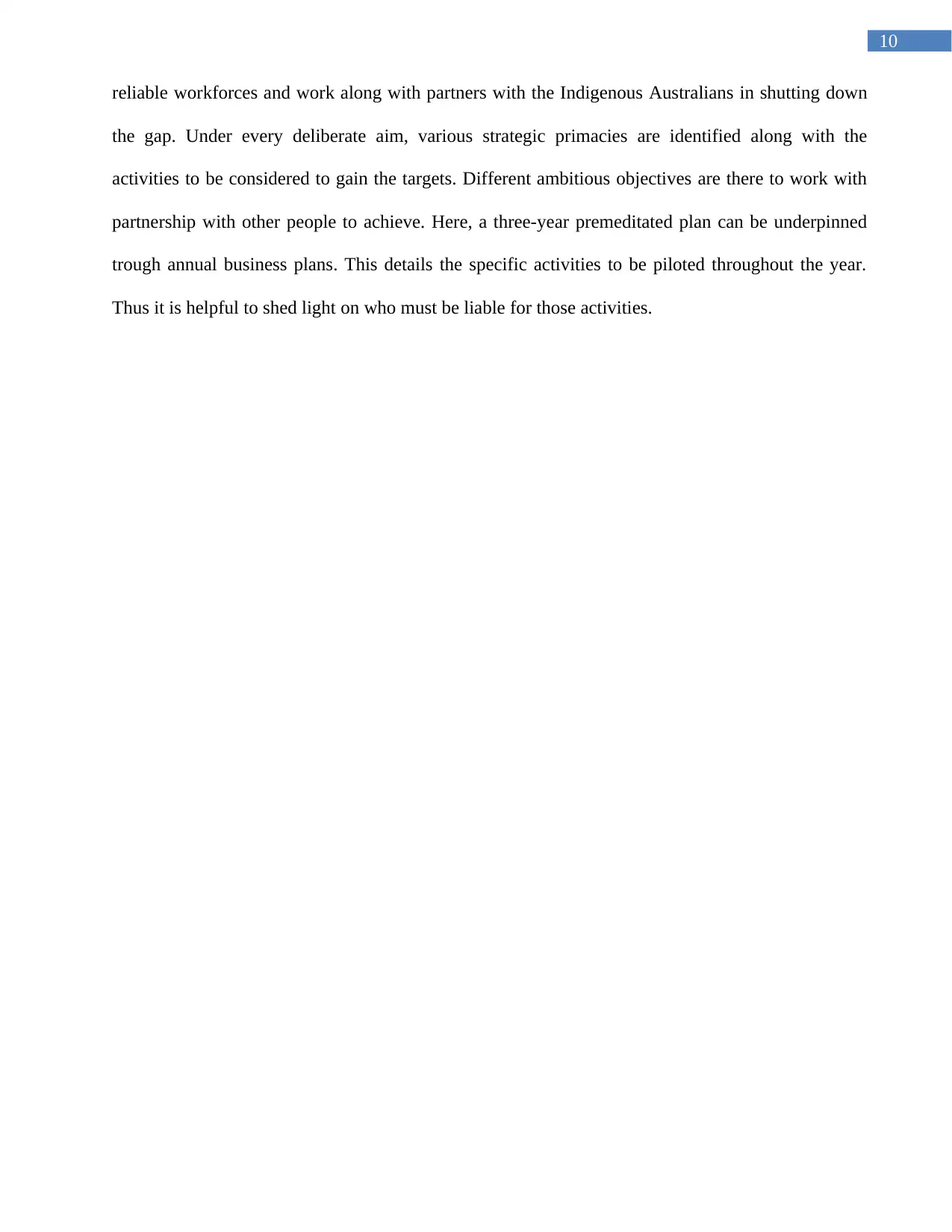
10
reliable workforces and work along with partners with the Indigenous Australians in shutting down
the gap. Under every deliberate aim, various strategic primacies are identified along with the
activities to be considered to gain the targets. Different ambitious objectives are there to work with
partnership with other people to achieve. Here, a three-year premeditated plan can be underpinned
trough annual business plans. This details the specific activities to be piloted throughout the year.
Thus it is helpful to shed light on who must be liable for those activities.
reliable workforces and work along with partners with the Indigenous Australians in shutting down
the gap. Under every deliberate aim, various strategic primacies are identified along with the
activities to be considered to gain the targets. Different ambitious objectives are there to work with
partnership with other people to achieve. Here, a three-year premeditated plan can be underpinned
trough annual business plans. This details the specific activities to be piloted throughout the year.
Thus it is helpful to shed light on who must be liable for those activities.

11
References:
Altman, J. (2018). Banking and Financial Services in Rural, Regional and Remote Australia-
Banking and Financial Services in Rural, Regional and Remote Australia.
Bainbridge, R et.al (2013) Coming to an ethics of research practice in remote Aboriginal Australian
community. Contemporary Nurse: A journal for the Australian Nursing Profession. Vol 46,
Issue 1, pp 18-27
Barlow, D.M. 1997, “Electronic community networks in rural Australia/>/>: A model for social
development in the Information Society”, Australian Social Work, vol.50(1), pp.3-8
Galambos, C., Wilson Watt, J., Anderson, K. Danis, F. Journal of Social Work Values and Ehics.
Habibis, D., Phillips, R., Phibbs, P., & Verdouw, J. (2015). Identifying effective arrangements for
tenancy management service delivery to remote Indigenous communities. AHURI
Positioning Paper, 165, 1-51.
Kirby, S., Held, F. P., Jones, D., & Lyle, D. (2018). Growing health partnerships in rural and remote
communities: what drives the joint efforts of primary schools and universities in maintaining
service learning partnerships?. Primary health care research & development, 19(5), 503-517.
Kral, I. (2012) Talk, text and technology: literacy and social practice in a remote Indigenous
community. eBook Multilingual Matters, Bristol.
Lovell, J. (2016). Key Factors in the Attraction and Retention of Local Remote Staff in Northern
Australia. In Developing Northern Australia Conference: Above the line-unleashing the
North's potential (pp. 23-32). Association for Sustainability in Business Inc..
References:
Altman, J. (2018). Banking and Financial Services in Rural, Regional and Remote Australia-
Banking and Financial Services in Rural, Regional and Remote Australia.
Bainbridge, R et.al (2013) Coming to an ethics of research practice in remote Aboriginal Australian
community. Contemporary Nurse: A journal for the Australian Nursing Profession. Vol 46,
Issue 1, pp 18-27
Barlow, D.M. 1997, “Electronic community networks in rural Australia/>/>: A model for social
development in the Information Society”, Australian Social Work, vol.50(1), pp.3-8
Galambos, C., Wilson Watt, J., Anderson, K. Danis, F. Journal of Social Work Values and Ehics.
Habibis, D., Phillips, R., Phibbs, P., & Verdouw, J. (2015). Identifying effective arrangements for
tenancy management service delivery to remote Indigenous communities. AHURI
Positioning Paper, 165, 1-51.
Kirby, S., Held, F. P., Jones, D., & Lyle, D. (2018). Growing health partnerships in rural and remote
communities: what drives the joint efforts of primary schools and universities in maintaining
service learning partnerships?. Primary health care research & development, 19(5), 503-517.
Kral, I. (2012) Talk, text and technology: literacy and social practice in a remote Indigenous
community. eBook Multilingual Matters, Bristol.
Lovell, J. (2016). Key Factors in the Attraction and Retention of Local Remote Staff in Northern
Australia. In Developing Northern Australia Conference: Above the line-unleashing the
North's potential (pp. 23-32). Association for Sustainability in Business Inc..
⊘ This is a preview!⊘
Do you want full access?
Subscribe today to unlock all pages.

Trusted by 1+ million students worldwide
1 out of 13
Related Documents
Your All-in-One AI-Powered Toolkit for Academic Success.
+13062052269
info@desklib.com
Available 24*7 on WhatsApp / Email
![[object Object]](/_next/static/media/star-bottom.7253800d.svg)
Unlock your academic potential
Copyright © 2020–2025 A2Z Services. All Rights Reserved. Developed and managed by ZUCOL.





